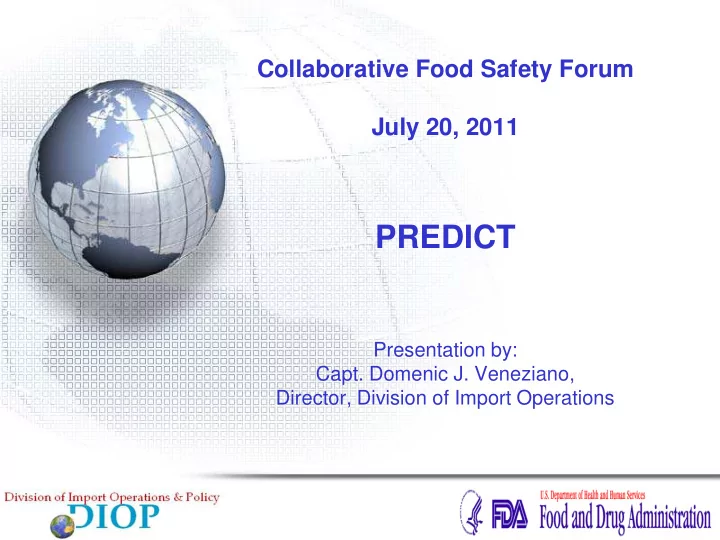

Collaborative Food Safety Forum July 20, 2011 PREDICT Presentation by: Capt. Domenic J. Veneziano, Director, Division of Import Operations
PREDICT Predictive Risk-based Evaluation for Dynamic Import Compliance Targeting Purpose: Improve import screening and targeting to Prevent the entry of adulterated, misbranded, or otherwise violative goods Expedite the entry of non-violative goods Method: Replace the admissibility screening portion of FDA’s legacy electronic system for processing import entries.
PREDICT is not MARCS Entry Review • PREDICT functions mostly behind the scenes. • MARCS Entry Review replaces the legacy entry review screens from OASIS. • Entry reviewers have access to PREDICT screening results through a “mash-up” within MARCS Entry Review. MARCS MARCS Imports MARCS Entry Review PREDICT
FY 2002 – 2011* LINES 25,000,000 23.8 21.1 20,000,000 18.5 17.2 16.0 15.0 15,000,000 13.7 11.9 9.4 10,000,000 7.9 5,000,000 0 FY 2002 FY 2003 FY 2004 FY 2005 FY 2006 FY 2007 FY 2008 FY 2009 FY 2010 FY 2011* SECTION I. IMPORT STATS A. CATEGORIES ORA/ORO/DIOP/SYSTEMS BRANCH (HFC-171)
PREDICT purpose and method Improve the targeting of entry lines by – Scoring each entry line on the basis of risk factors and surveillance requirements Increase the number of automated, real-time, risk-based “may proceed” decisions, thereby giving entry reviewers more time to evaluate higher-risk lines For those lines not given an automated “may proceed,” providing reviewers with the line scores and the reasons for those scores 1 of 2
PREDICT purpose and method Use automated data mining and pattern discovery for rules development Utilize open-source intelligence Provide automated queries of Center databases where relevant (i.e., registration and listing, marketing approval status, low-acid canned food scheduled processes, etc.) 1 of 2
Examples of source data for PREDICT screening rules Results of field exams and sample analyses of previous entries Results of facility inspections, foreign and domestic Ratings of inherent product risks Accuracy of product and facility coding by entry filers and importers 1 of 2
Examples of source data for PREDICT screening rules Data anomalies within the current entry Admissibility history with respect to the manufacturer, exporter, importer, and consignee for the current product (at industry and more specific levels) Open source intelligence pertaining to the manufacturer, foreign locale, product, etc. 2 of 2
Risk types to be included in targeting scores Compliance risk (probability of violation) Product-related Inherent health risk (Type 1) Incremental health risk in view of previous FDA analytical results for products of the same manufacturer (Type 2) Risk of the product being the target of economic adulteration with hazardous consequences; i.e., wheat flour or milk adulterated with melamine and cyanuric acid; counterfeit drugs with missing or different inactive ingredients, etc. (Type 3)
PREDICT and FSMA
Recommend
More recommend